Digital Era Fueling Adoption of All-Flash Object Storage
While 95% of respondents using flash in object environments, only 23% using all-flash storage solution
This is a Press Release edited by StorageNewsletter.com on February 10, 2021 at 2:19 pmPublished on January 2021, this Research Insights Paper, commissioned by Scality SA, was written by Scott Sinclair, senior analyst, and Monya Keane, senior research analyst, Enterprise Strategy Group, Inc.
Executive Summary
Digital business initiatives are fueling an increased emphasis on creating, storing, and using data. This trend has led to increased adoption of all-flash object storage.
It may also help bolster organizations’ viewpoints about their IT groups. Only 6% of the line-of-business executives surveyed by ESG said they viewed their company’s IT group as a competitive differentiator for the business, while 25% regarded IT as a business inhibitor. Among the executives who believed their IT organization was inhibiting business success, 43% of tem said it was because their workers were having difficulty accessing the data they needed for business operations and analysis.
Research Objectives of This Project
This study encompassed 205 IT professionals currently responsible for their organizations’ storage decisions and forward-looking infrastructure strategies within enterprise organizations of 1,000 employees or more.
The focus of the project involved:
• Investigating the adoption of, considerations for, and benefits delivered by all-flash object storage.
• Understanding the existing challenges with unstructured data generally and object storage specifically.
• Investigating the needs, features, sizing, and applicable/attractive workloads for all-flash object storage.
Report Conclusions
The key findings of this research can be summarized as follows:
• All-flash object storage is early in the adoption phase but will become pervasive. While 95% of respondents report using flash in object environments, only 23% of those respondents report using an all-flash storage solution today. Of those not using all-flash object storage today, 87% expect they will evaluate the technology in the next 12 months.
• More than three-quarters of respondents (77%) reported that digital initiatives and new workloads are driving their interest in all-flash object storage.
• More than three-quarters (77%) of respondents at organizations already using all-flash object storage claim it has either been a game changer for the organization (28%) or has had a high impact (49%).
• Users report a variety of benefits, identifying, on average, between 6 and 7 realized benefits-including improving application development, accelerating AI/ML environments, empowering business intelligence/analytics, and/or increasing infrastructure performance and utilization while lowering TCO.
Strong Adoption with Growing Interest for All-Flash Object Storage
Digital storage capacities continue to grow. In this study, 94% of the surveyed organizations reported that they maintain more than 1PB of active, primary unstructured data capacity, and 41% maintain more than 25PB. Given an average storage growth rate of 34% annually, these data sets will likely double every two and a half years.
ESG observed a strong level of flash adoption in respondents’ object storage environments. Nearly every participant (95%) reported that flash represents at least part of their on-premises object storage, and about a quarter (23%) of those have an all-flash object storage solution in operation.
Across represented industries, adoption was relatively lowest in healthcare, at 14%. But even in that sector, nearly half of the surveyed healthcare companies (49%) identified that they definitely would evaluate an on-premises, all-flash object storage solution in the next 12 months, a rate 26% higher than the overall average. The healthcare sector is catching up.
And among organizations in general that have not already deployed all-flash object storage, 87% expected that they will evaluate one in the next 12 months (see Figure 1).
Figure 1. Expectation to Evaluate All-Flash Object Storage in Next 12 Months
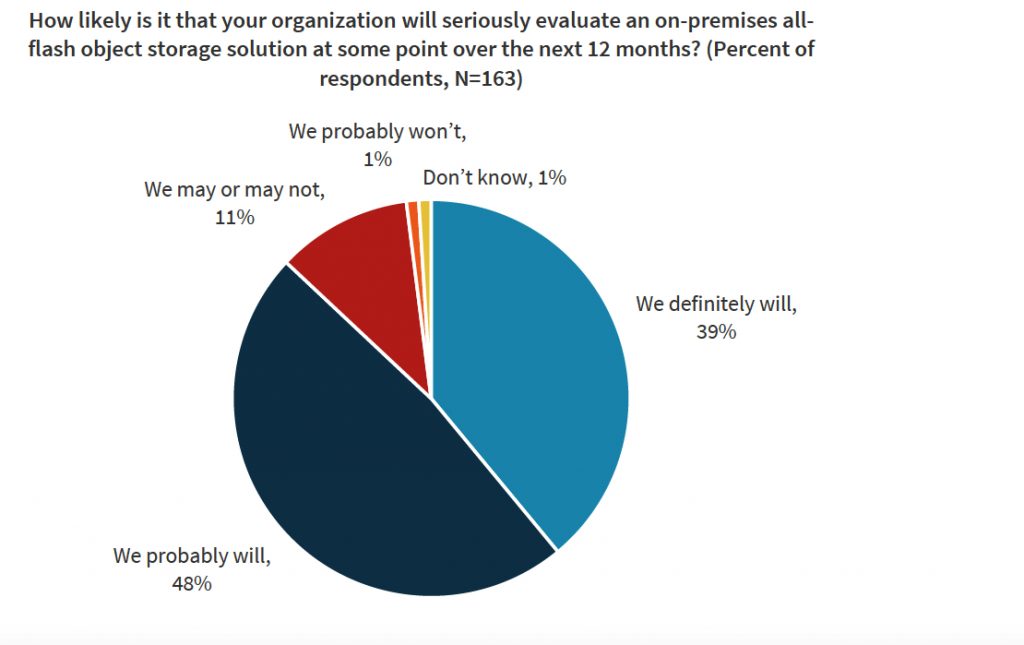
New Workloads and Digital Initiatives Are Fueling Interest in All-Flash Object Storage
New workloads appear to be the primary driver of all-flash object storage adoption. Given the rise of digital initiatives as well as cloud-native, container-based workloads-along with the need to utilize unstructured data to fuel application development, business intelligence, analytics, and even ML – organizations increasingly demand high-performance access to large volumes of unstructured data.
Digital initiatives are not the only drivers. However, more traditional use cases also are propelling increased demands for performance. Notably, high-performance data restoration (high-speed recovery) is playing its own role in spurring adoption of all-flash object storage (see Figure 2).
Figure 2. Combined 77% Identify New Initiatives/Workloads Driving Need for All-Flash Object Storage
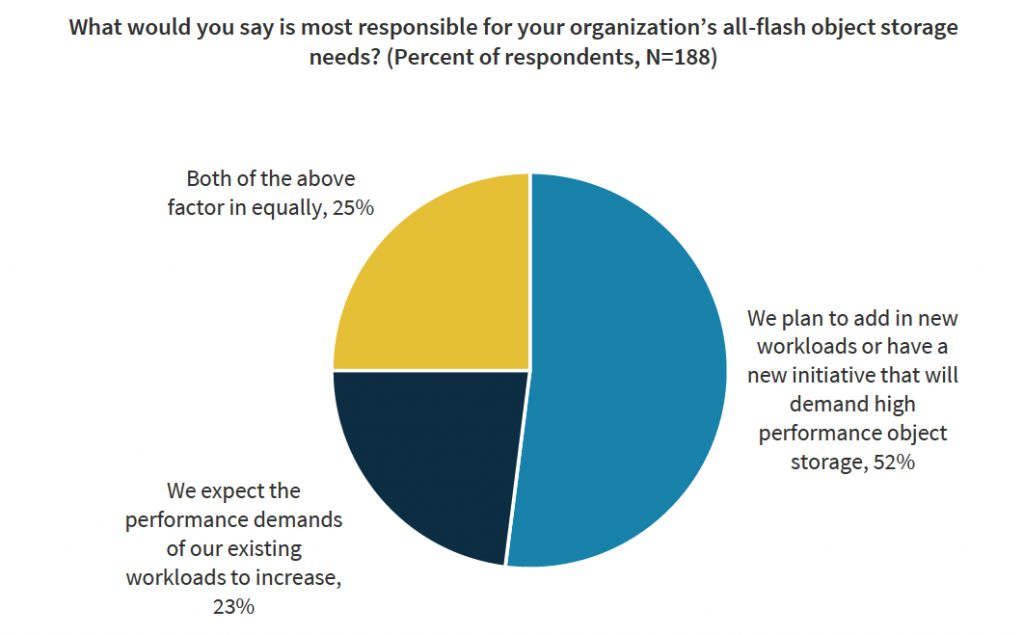
These findings align with what ESG has seen in terms of IT spending in general.2 Digital initiatives are now common areas for investment.
Consider that:
• Application development plays a foundational role in digital business initiatives. A vast majority of surveyed IT organizations (95%) reported that their businesses are in some stage of digital transformation.
• Additionally, 64% of surveyed organizations that are using AI/ML anticipated an increase in spending related to those technologies in 2020.
• And 49% of IT decision makers whose organizations use business intelligence and analytics expected their organizations to increase spending in that area in 2020.
For Users, All-Flash Object Storage Is Game Changer
All-flash object storage is clearly playing a key role in providing the modern infrastructure necessary to support these new initiatives (see Figure 3). ESG found that a combined 77% of the respondents believe that all-flash object has either been a game changer for them (28%) or has had a high impact on their organization (49%).
Figure 3. All-Flash Object Is Making Large Impact
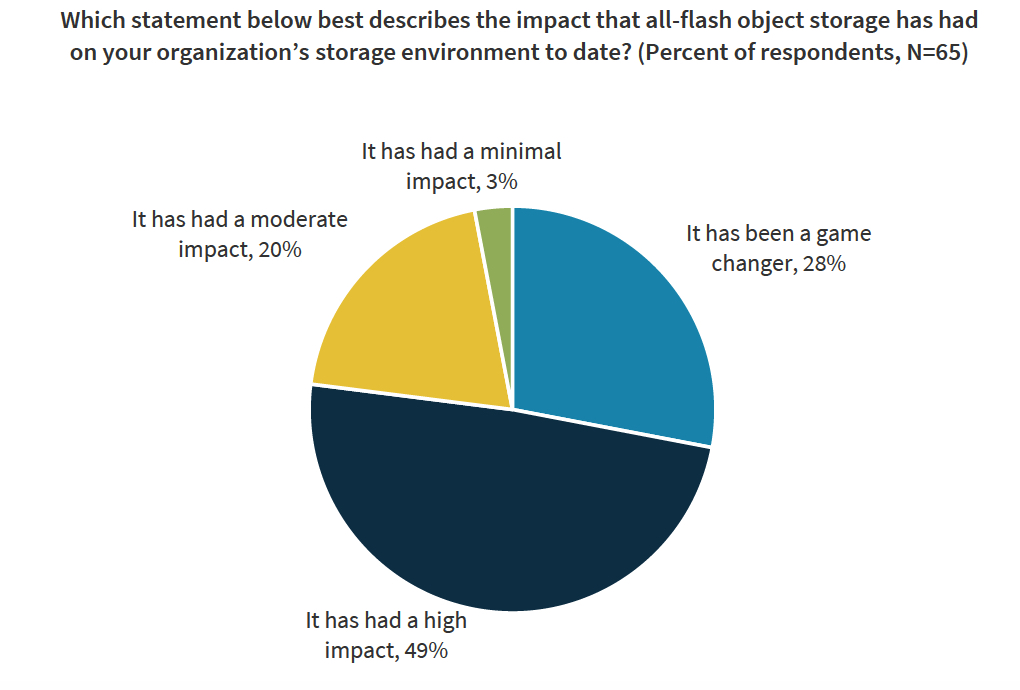
Several use-case-specific benefits that highlight the value all-flash object storage delivers to digital initiatives tied to application development, AI, and BI/analytics (see Figure 4).
Figure 4. Realized Benefits From All-Flash Object Storage
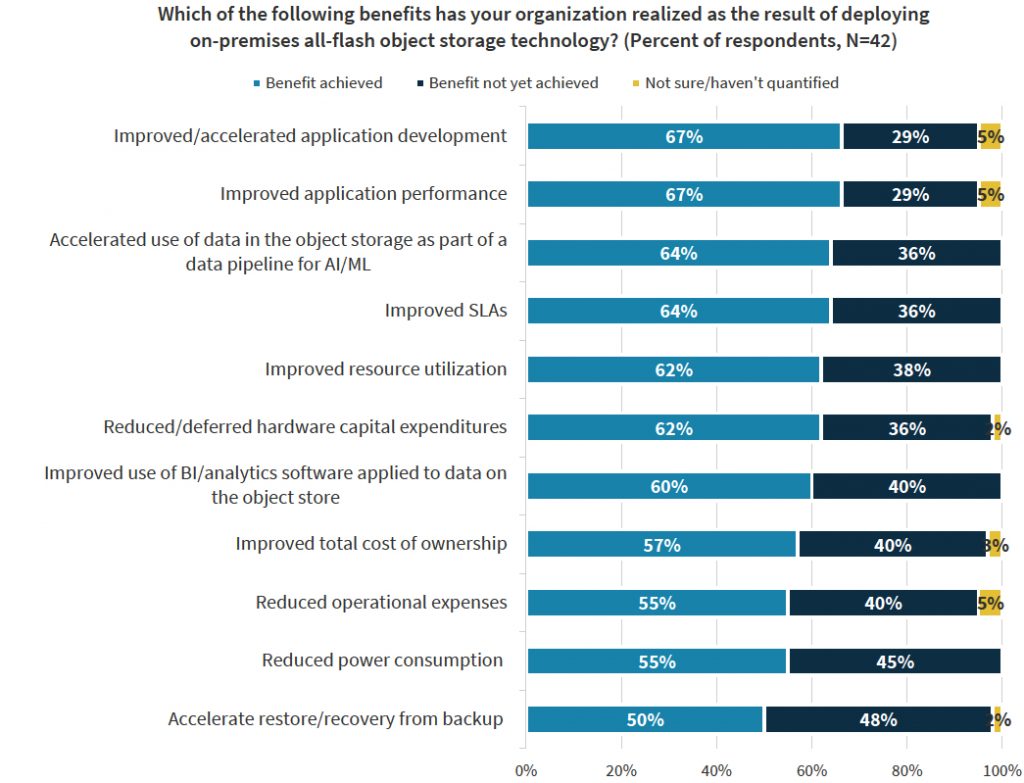
A connection exists between those workloads and all-flash object storage’s ability to accelerate performance in a massive storage environment. Research into common AI/ML challenges certainly highlights the need for these capabilities: in separate research, ESG surveyed 300 data-focused IT professionals involved with their organizations’ AI/ML initiatives. They identified the main challenges and barriers their organizations experienced with AI/ML projects.
Those challenges/barriers were:
• The cost of IT infrastructure required (cited by 35% of respondents).
• The need for better IT infrastructure capabilities (cited by 29%). (3)
Directional Finding: Top Benefits of All-Flash Object Storage by Industry
Financial services
• Improved/accelerated use of data in the object storage as part of a data pipeline for ML/AI (76%).
• Improved application performance (76%).
Government
• Improved resource utilization (70%).
• Reduced operational expense (60%).
Healthcare/life sciences
• Improved TCO (83%).
• Improved/accelerated application development (75%).
As Figure 4 illustrates, all-flash object storage also is helping IT to deliver on additional infrastructure-related key performance indicators such as improved SLAs, improved resource utilization, reduced TCO, and lower operational expenses.
In other words, the use of all-flash object storage appears not to be a tradeoff between capability and cost. Rather, it is a win-win approach that delivers improved capabilities and reduces TCO (as identified by 57% of the respondent organizations).
The reported benefits shed light on why 80% of the survey participants said migrating workloads to all-flash object storage is either their most, or one of their most, important storage-related initiatives right now.
Top Considerations With All-Flash Object Storage
This report also investigated what organizations look for when they are selecting an all-flash object storage solution (see Figure 5).
Figure 5. Expectation to Evaluate All-Flash Object Storage in Next 12 Months
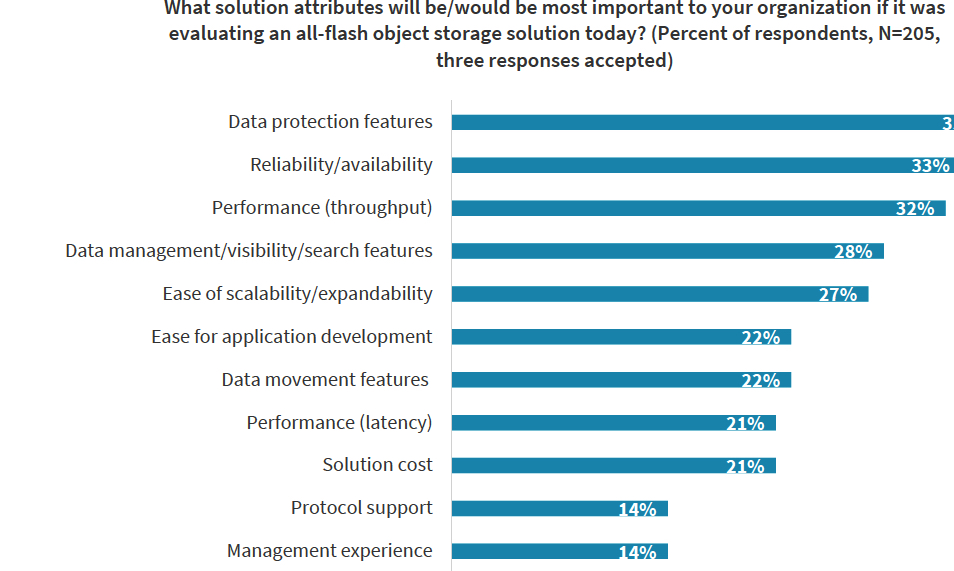
Capabilities for data protection and data availability are very common decision factors, which is unsurprising. In the context of a massive-scale storage environment, the protection of data is and should be always a top priority.
Also, for the majority of these environments, good throughput tends to be a much more important factor (cited by 52% more respondents) than lower latency, which traditionally was the more common storage performance characteristic to be considered important when making a buying decision. Of course, any individual organization’s specific priorities will depend on the needs of its unique application environment.
Several considerations appear to center on simplicity. Injecting simplicity into the storage environment could come in the form of:
• Improving search capabilities to help line-of-business teams find data they need.
• Making data access easier for application developers.
• Simplifying the management of these massive environments for IT
admins.
All-Flash Object Storage – Top Considerations by Industry
Financial services
• Reliability/availability (47%).
• Data management/visibility/search features (32%).
Government
• Performance throughput (34%).
• Data protection (29%).
Healthcare/life sciences
• Data protection (36%).
• Ease of scalability/expandability (32%).
Conclusion
All-flash object storage deployments and evaluations are prevalent now, likely driven by digital initiatives. At this point, the mentality rightly should be: “Everyone else is doing it. You should too or risk falling behind.”
For organizations using all-flash object storage, it has been a game changer, or at least it has provided a high positive impact by boosting cloud-native/container-based application development and portability. AI/ML projects, and business intelligence/analytics efforts-all activities that support modern digital initiatives.
In addition, all-flash object storage improves IT resource utilization and can even make management easier, which helps to reduce operational expenses and TCO.
For these reasons and more, all-flash object storage appears well on its way to becoming a foundation of the modern storage ecosystem.
Research Methodology and Parameters
This study – fielded between August 31, 2020 and September 12, 2020 – covered IT professionals currently responsible for their organization’s storage decisions and forward-looking infrastructure strategies.
The respondents in the study:
• Work for enterprise organizations of 1,000 employees or more.
• Manage IT environments with more than 500TB of active, unstructured storage.
• Work for organizations in financial, government, healthcare/life sciences, technology/telecommunications, and M&E industries.














 Subscribe to our free daily newsletter
Subscribe to our free daily newsletter

